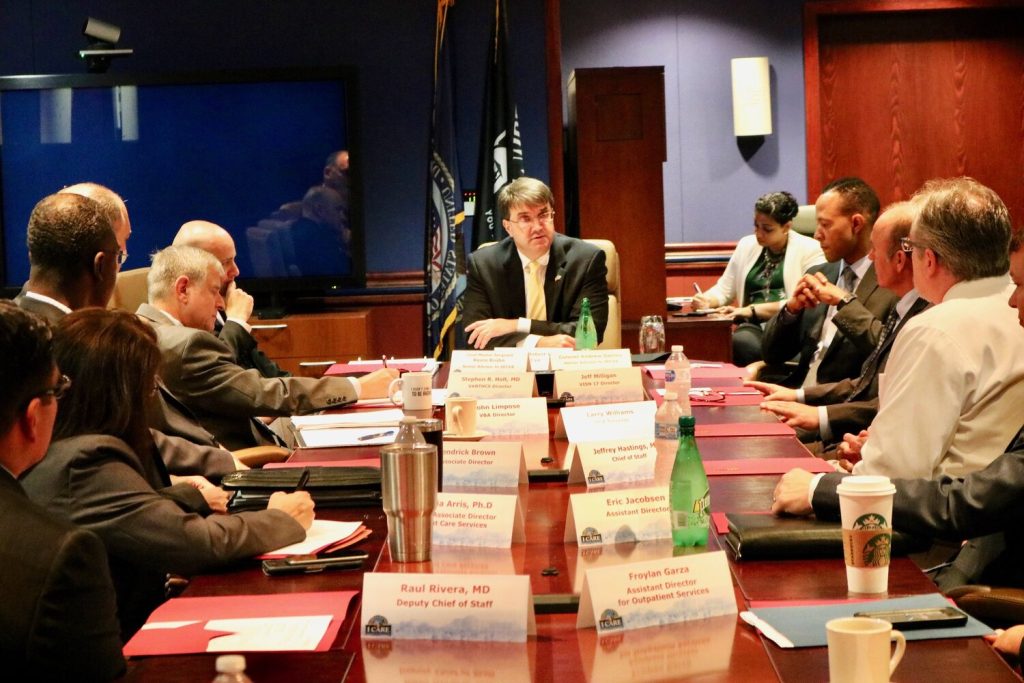THE YEAR IN REVIEW
By Brett W. Copeland
VHPI Executive Director
A radical overhaul of veterans’ dedicated health care system was rolled out in 2019. The VA MISSION Act, the successor to the VA’s much-troubled and consistently over-budget ‘Choice’ program was deployed in June. So far, it has sent hundreds of thousands of veterans (223,000 in Texas alone) out of the VA health care system to private sector providers in the hastily-assembled Community Care Network.
As VHPI predicted (among many others, including the Commission on Care and the GAO), the cost of rapidly expanding private sector care is just another mountain weighing down the United States’ $22 trillion national debt. Worse still, it is expected to cannibalize the VA’s programs. Last week, VA’s 2020 spending proposal included $8.9 billion marked for the private sector. That figure is slated to increase to at least $11.3 billion the following year.
If invoices rather than performance data are used to judge the effectiveness of private providers, as one health care insurer suggested, then the VA MISSION Act would be considered a spectacular success. So successful that Optum has indicated it wants millions more on top of its initial $55 billion contract through 2026 to expand the network again.
But veterans’ health and well-being can’t be measured in invoices. As former VA Secretary Dr. David Shulkin told VHPI, the current standards employed by the Department of Veterans Affairs – centered on access, rather than quality – are being used as a tool to break the Veterans Health Administration. There is no substitute for quality.
Key partnerships are critical for reaching veterans who do not use the Veterans Health Administration. However, for the remainder of 2019, Secretary Robert Wilkie seemed intent to expand the VA’s partner network with many organizations that do not have a documented track record of success in suicide prevention. It often feels like the Mar-a-Lago three and others with a vested interest in seeing VA dollars flow to non-VA providers are still calling the shots. Congressman turned lobbyist Jeff Miller is one of the people who are dedicated to making sure this continues and that cash flows freely to the private sector is former.
Miller’s legacy as chairman of the House Committee on Veterans’ Affairs turned out to be two-fold. He oversaw the beginnings of the current privatization efforts through ‘Choice’ and the origins of the MISSION Act. He also turned veterans’ genuine health care challenges into more political propaganda.
The House Committee on Veterans Affairs has seen its history of bipartisanship rapidly erode ever since, culminating with the walkout of Republican lawmakers during a bill markup over healthcare services delivered to women veterans. Unfortunately, caring for those who served in uniform has become just another political battlefield in today’s zero-sum partisan warfare. To try and cut through the fog surrounding veterans and their care, VHPI created The Congressional Guide to Veterans’ Health Care. The guide explains the ailments veterans suffer from and the services that have proven effective in caring for their wounds of war. We hope that this critical information will help Congressional staffers refocus their efforts to enhance the care of the veterans they serve.
The kind of information VHPI provides will help both policymakers and journalists understand the context in which the debate about veterans’ healthcare unfolds. Very few on Capitol Hill or in the media ask the crucial question when considering the Veterans Health Administration (VHA): how does it compare to the rest of the US healthcare system?
People seem to forget that the United States has the most wasteful and expensive healthcare system in the industrialized world. Although we have the highest costs in the developed world and rank embarrassingly low on major metrics (ranking 37th in worldwide health care per the World Health Organization), yet corporate media and political pundits still portray the Veterans Health Administration as a failed system.
Unfortunately, independent reporters and journalists at the national, state and local levels don’t have the time to dig deep into the complicated world of veterans’ health care delivery and its place in our broader healthcare landscape. It’s one of the reasons we created The Reporter’s Guide to Veterans’ Health Care. The guide provides the necessary information that helps journalists understand veterans’ unique care needs and how the Veterans HA addresses them.
We hope that with this context, the media will begin to shift from reporting only on the problems that occur in the nation’s largest health care system and will also add reports on its many successes. It excels in everything from suicide prevention to better care and management of chronic illnesses.
Reporters should consider how the VHA can serve as a model for a non-VA health care system. Private sector care in the United States needs lessons on how to implement effective care coordination, deliver mental healthcare, remedy an extreme shortage of primary care providers, and deal with care at the end of life. The VHA does all this superbly which is why, in many markets studies have shown that it outshines the private sector system. CQ Researcher’s ‘Veterans’ Struggles’ is a good starting point, but more must be done.
Another issue Congress and the media must address is the staffing crisis in the VHA. When producing the Driving the Week Newsletter, we see a lot of coverage of Veterans Affairs facilities across the country. Whenever a story is published about the failure of a VA facility, more often than not, inadequate staffing is an unexplored root cause. Sadly few reporters delve deeply into the problem of understaffing and investigate VA’s top leadership team who insist the 39,000 vacancies don’t impact veterans’ care.
Few question the wisdom of the way Secretary Wilkie and his team (many of whom are alumni of the Koch Brothers’ Concerned Veterans for America) deals with staffing shortages – as yet another excuse to push veterans into the private sector where they’ll have to compete with non-veteran Americans for care. Wilkie and his team seem intent not only on shifting care to the private sector but also closing VHA facilities. VHA’s Executive-In-Charge alleged that one of the VA’s most utilized and acclaimed facilities in the San Francisco Bay Area rarely saw any veterans at all.
What will all this mean for 2020? Will the politicization of veterans’ health continue in 2020? Suzanne Gordon and Jasper Craven will have those predictions for you the first Monday of the new year.


